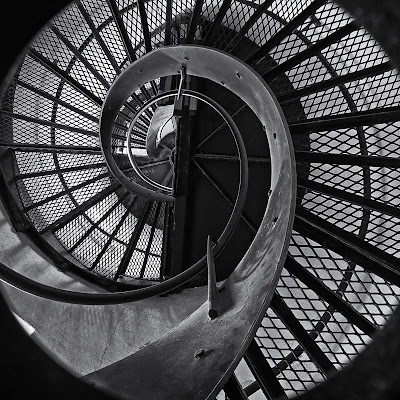Huerta del manzano. Dibujo en tinta, bajado de Google images. Sin referencia de autor.
En el barrio nuevo, en medio de desplantes arquitectónicos y de complejos urbanísticos, de bloques de cemento rectangulares y perpendiculares a la tierra, en una encrucijada de calles anchas y atravesadas de señales pintadas de blanco, en un terreno que el azar de las especulaciones conservó, hay una vieja casa campesina, de la época en que el barrio, nuevo, prolongación artificial de la ciudad, era todavía campo. La casa está en una especie de hondonada que dominan las calles prolijas, y algo salvaje persiste todavía en las veredas sin embaldosar, protegidas por plátanos periódicos, que Pichón Garay recorre dos o tres veces por semana, en camino hacia los terrenos de la Universidad. Hay algo en esa casa, en las campánulas de un azul violáceo, que cubren sus cercos, en los terraplenes que la rodean, en un contraste violento y tranquilo con el decorado urbano, que le recuerda a Pichón Garay no únicamente otros lugares sino incluso otros tiempos, como si esa casa visible en el espacio fuese también, a su manera, una interferencia temporal.
En el patio de la casa hay un huerto, y junto al tejido que separa el huerto de la casa, antiguo, un manzano. A cada primavera, el manzano produce un llamado blanco que cada otoño, de evanescente que era, se vuelve duro, denso y rojizo: entre las hojas verdes pululan, con resplandores secos, las manzanas. Rodeados de un horizonte blanco de monoblocs rectos, idénticos y regulares, en el manzano perduran restos rurales que atestiguan presencias menos geométricas y organizadas, en las que renace el viejo rigor entre campo y ciudad.
Esa mañana, como otra muchas, mientras P. G., en un otoño todavía indeciso, pasaba por ahí, recibió, del manzano, un llamado más dulce y sin embargo más perentorio, que lo incitó a pararse y a mirar. Aunque crecía en el fondo del terraplén desde el que Pichón lo miraba, y a unos quince metros de distancia, el árbol no perdía grandeza, pero tampoco parecía desmesurado; firme y abordable, condecía a las medidas humanas. Pichón Garay lo contempló largo rato, y a diferencia de experiencias más prestigiosas, no fue, en determinado momento, árbol, en la intensidad de la contemplación, ni las presencias materiales -tenemos pasto, autos, edificios, sujeto y árbol- declinaron sus apariencias, para reintegrarse otra vez, redistribuidas, en el todo, sino que, muy por el contrario, obtuvieron, durante unos momentos, límites precisos, cuerpos densos, identidad, en el aire soleado, alrededor del manzano, que ordenaba, plácido, el espacio alrededor. En ese estado, próximo a la felicidad, P. G. creyó comprender o sentir, mejor, si la palabra, todavía, es admisible, que el árbol estaba como sostenido por una fuerza, y que comprendía, también, el horizonte de casas y el cielo, la verdura del huerto, el aire y el día, y a sí mismo también, todos separados y presentes, en relación, densos en la transparencia, mandando en la mañana más que el sol turbio de otoño que estaba adentro también, continuas, radiaciones. (1980)
Fuente:


















































